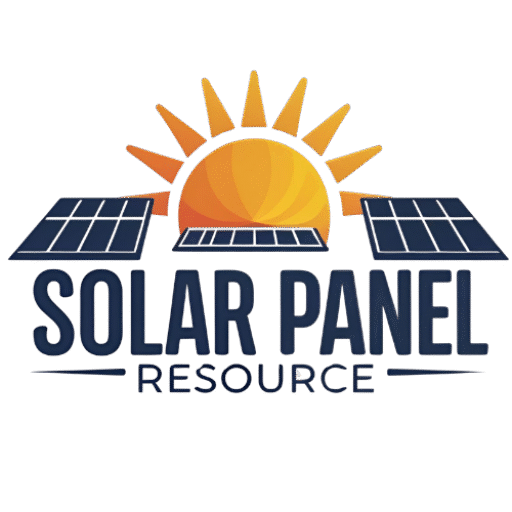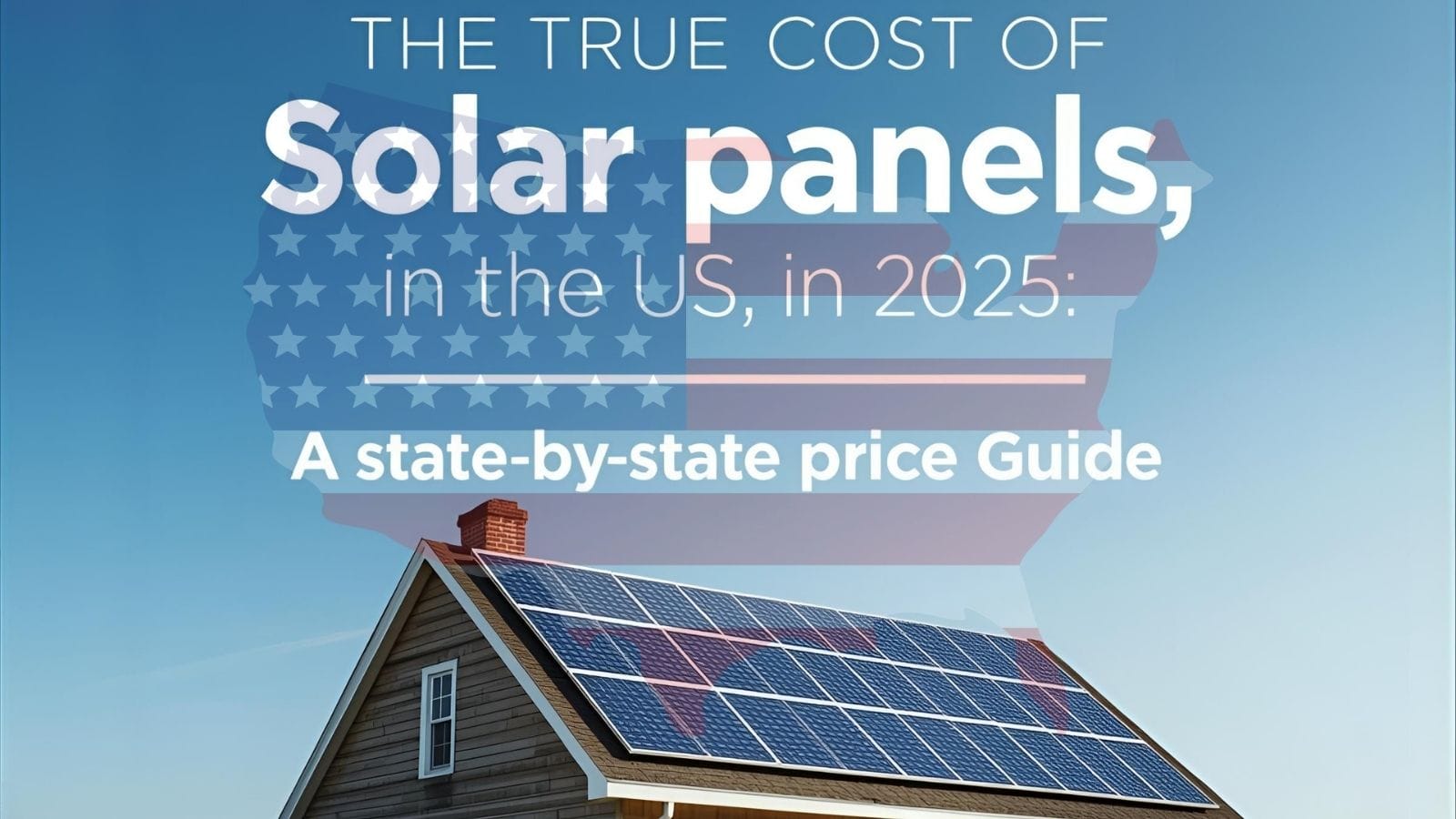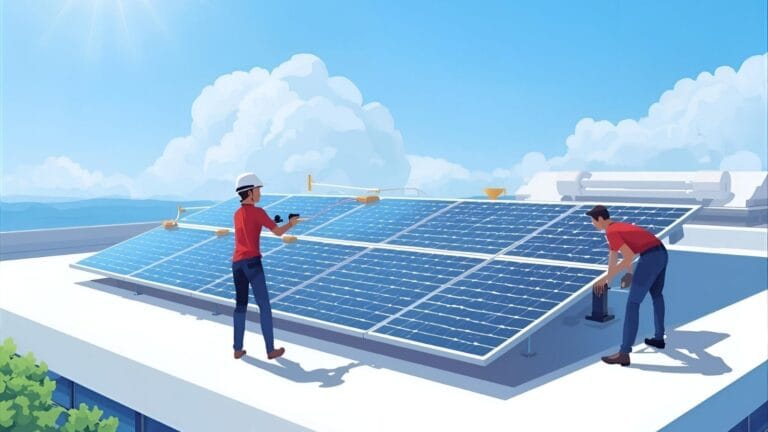The True Cost of Solar Panels in the US in 2025: A State-by-State Price Guide
One of the first and most important questions on the journey to solar energy is: “How much is this actually going to cost?” The answer is more complex than a simple sticker price. The true cost of solar panels in 2025 is a dynamic figure, influenced by your location, the equipment you choose, and a landscape of powerful financial incentives.
Forget vague estimates. This comprehensive guide is designed to demystify solar panel pricing. We will break down every component of the solar panel installation cost, explore the key factors that cause prices to vary, and provide a detailed state-by-state analysis to help you budget accordingly. By the end, you’ll understand not just the price, but the incredible value solar can offer.
Understanding Solar Panel Pricing: More Than Just the Sticker Price
When you start researching solar, you’ll encounter a few key terms that define the cost. Understanding these metrics is the first step to comparing quotes and recognizing a fair deal.
Price Per Watt ($/W): The Industry Standard Metric
The most common way to measure solar costs is in **price per watt ($/W)**. This metric allows for an apples-to-apples comparison between systems of different sizes. It’s calculated by dividing the total gross cost of the system by its total power output in watts.
For example, if a 6-kilowatt (6,000-watt) system costs $18,000 before any incentives, the price per watt is $18,000 / 6,000W = $3.00/W.
What’s Included in the Total Solar Installation Cost?
The price per watt isn’t just for the physical panels. It’s an all-inclusive figure that typically covers:
- Solar Panels: The core hardware that captures sunlight.
- Inverters: Devices that convert the DC electricity from panels to AC electricity your home can use.
- Racking & Mounting: The equipment that secures the panels to your roof.
- Labor: The cost for the professional crew to design and install the system.
- Permitting & Inspection: Fees paid to your local municipality to ensure the system is safe and code-compliant.
- Engineering & Design: The work done to create a custom solar plan for your specific home and energy needs.
Key Factors That Influence the Cost of Solar Panels in 2025
Why can a 6kW system cost $16,000 in one state but over $20,000 in another? Several key variables directly impact your final solar panels price. Acknowledging these factors is crucial for understanding your quotes.
1. System Size (kW): How Much Power Do You Need?
The biggest cost driver is the size of the system, measured in kilowatts (kW). The more electricity you use, the larger the system you’ll need to offset your bill, and the higher the total cost will be. However, larger systems often have a lower price per watt due to economies of scale.
2. Equipment Quality: Panels, Inverters, and Racking
Not all solar equipment is created equal. You have choices to make:
- Panel Type: High-efficiency monocrystalline panels cost more upfront than polycrystalline or thin-film panels but produce more power in less space.
- Inverter Type: A standard string inverter is the most budget-friendly option, while microinverters or power optimizers offer better performance (especially on complex or partially shaded roofs) at a higher cost.
- Brand Reputation: Tier 1 manufacturers with strong warranties and a long track record often command a higher price.
3. Roof Characteristics: Complexity, Material, and Pitch
Your roof is the foundation of your solar system. A simple, south-facing asphalt shingle roof is the easiest and cheapest to install on. Costs can increase for roofs with steep pitches, multiple levels, skylights, or specialized materials like slate or tile that require more care and specialized mounting hardware.
4. Labor and Installation Costs by Region
The cost of labor varies significantly across the country. Installers in states with higher costs of living, more stringent licensing requirements, or stronger union presence will naturally have higher labor rates, which is reflected in the final price per watt.
5. Permitting and Inspection Fees
Every municipality has its own fee structure for solar permits. While this is usually a smaller portion of the total cost, permitting in some complex jurisdictions can be more expensive and time-consuming, adding to the overall project price.
The Net Cost: How Incentives Dramatically Reduce Your Price
The “gross cost” is the number you see on an initial proposal. The number that truly matters is the “net cost”—the price you pay after all incentives. This is where the true cost of solar becomes much more attractive.
The 30% Federal Solar Tax Credit in 2025
The single most significant incentive is the federal Residential Clean Energy Credit, often called the Investment Tax Credit (ITC). In 2025, this allows you to subtract 30% of your total system cost directly from your federal taxes. For an $18,000 system, this is a massive $5,400 credit, bringing your net cost down to just $12,600.
State and Local Rebates: The X-Factor in Pricing
On top of the federal credit, many states, local governments, and utility companies offer their own incentives. These can include cash rebates, state tax credits, property tax exemptions, or performance-based incentives like SRECs (Solar Renewable Energy Credits). These programs are a major reason why the average cost of solar panels by state varies so much.
2025 Solar Panel Cost by State: A Detailed Breakdown
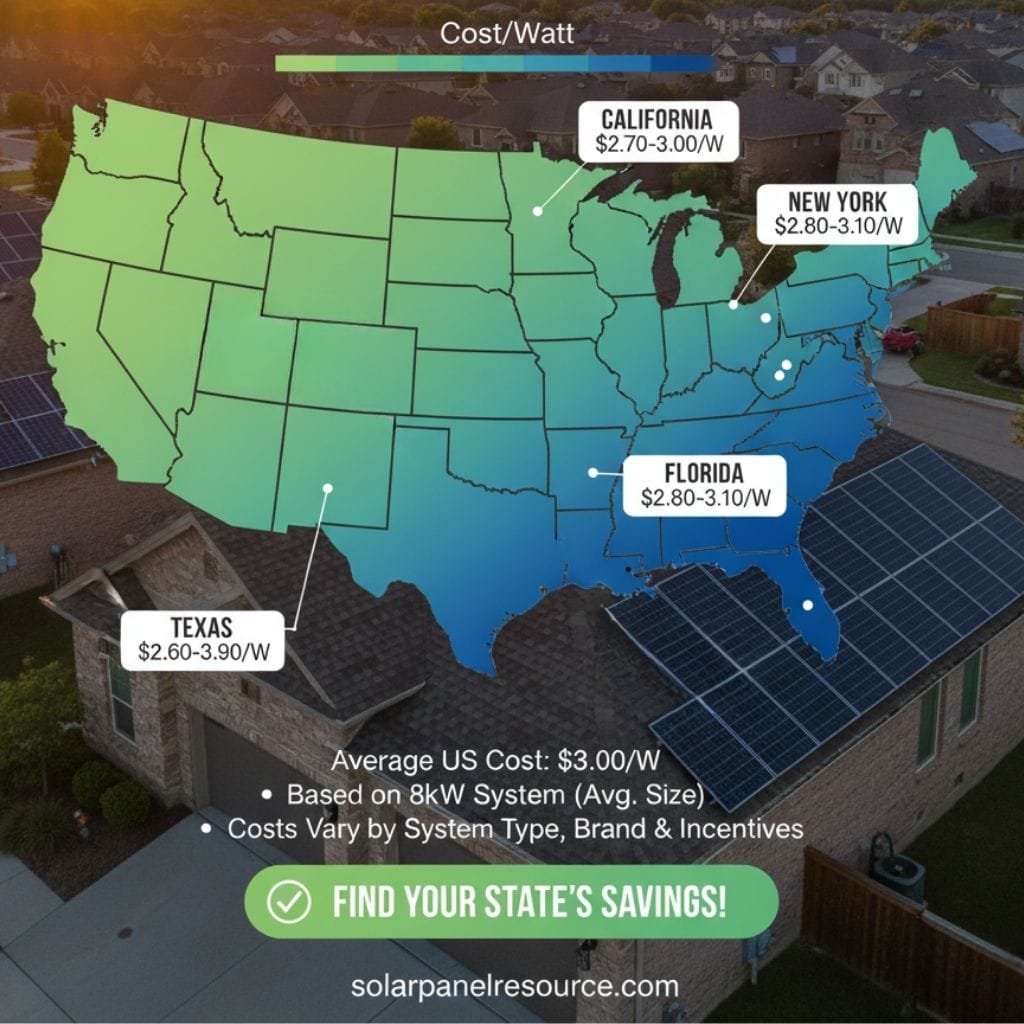
Now, let’s get to the numbers. The following is a breakdown of estimated solar panel costs for a representative sample of states in 2025. Prices are estimates based on market trends and can vary based on the factors listed above. The data is compiled from various industry sources, including market analysis from organizations like the Solar Energy Industries Association (SEIA).
(All costs are pre-incentive unless otherwise noted. A typical system size of 6kW is used for comparison.)
High-Cost States
These states often have higher labor costs and more complex regulatory environments but may also have strong state-level incentives to help offset the price.
- California: Avg. Price: $3.10 – $3.80/W. | 6kW System: $18,600 – $22,800. After 30% ITC: $13,020 – $15,960.
- Massachusetts: Avg. Price: $3.20 – $4.00/W. | 6kW System: $19,200 – $24,000. After 30% ITC: $13,440 – $16,800.
- New York: Avg. Price: $3.15 – $3.90/W. | 6kW System: $18,900 – $23,400. After 30% ITC: $13,230 – $16,380.
Mid-Range States
These states represent a competitive middle ground, with a balance of moderate costs and growing solar markets.
- Colorado: Avg. Price: $2.90 – $3.50/W. | 6kW System: $17,400 – $21,000. After 30% ITC: $12,180 – $14,700.
- Illinois: Avg. Price: $2.85 – $3.45/W. | 6kW System: $17,100 – $20,700. After 30% ITC: $11,970 – $14,490.
- Virginia: Avg. Price: $2.80 – $3.40/W. | 6kW System: $16,800 – $20,400. After 30% ITC: $11,760 – $14,280.
Low-Cost States
These states benefit from abundant sunshine, competitive labor markets, and large-scale adoption, driving down prices.
- Texas: Avg. Price: $2.60 – $3.20/W. | 6kW System: $15,600 – $19,200. After 30% ITC: $10,920 – $13,440.
- Florida: Avg. Price: $2.55 – $3.15/W. | 6kW System: $15,300 – $18,900. After 30% ITC: $10,710 – $13,230.
- Arizona: Avg. Price: $2.50 – $3.10/W. | 6kW System: $15,000 – $18,600. After 30% ITC: $10,500 – $13,020.
Are Solar Panel Prices Going Up or Down in 2025?
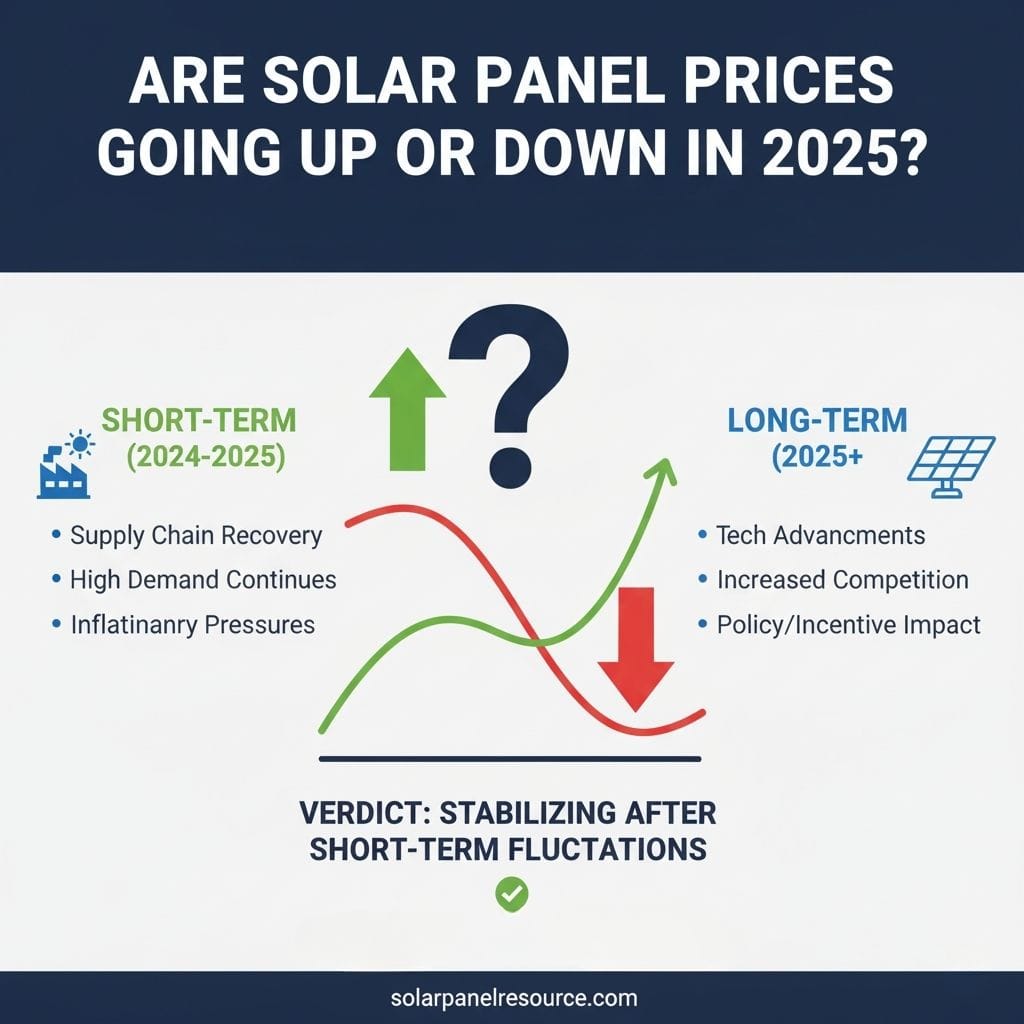
For over a decade, solar prices plummeted. Recently, the trend has been more complex. While still far cheaper than ten years ago, prices have stabilized and even slightly increased in the early 2020s before beginning to level off again.
Supply Chain and Material Costs
Global supply chain disruptions and fluctuations in the cost of raw materials like polysilicon can cause short-term price volatility. However, the industry is constantly adapting to become more resilient.
The Impact of Technology and Efficiency Gains
The long-term trend remains positive. Ongoing advancements in photovoltaic technology lead to more efficient panels that produce more power. This means you may need fewer panels to meet your energy goals, which helps to counteract other cost pressures.
Beyond the Panels: Other Potential Solar Costs to Consider
A trustworthy quote will be all-inclusive, but you should be aware of potential ancillary costs that could arise depending on your situation.
- Battery Storage Systems: Adding a battery to store excess power for use at night or during an outage will significantly increase the project cost, often by $10,000 or more.
- Electrical Panel Upgrades: Some older homes may need a main electrical panel upgrade to safely accommodate the new solar circuit, which can cost $1,500 – $3,000.
- Tree Removal or Roof Repairs: If significant shading needs to be addressed or your roof is near the end of its life, it’s best to handle these issues before installing panels.
How to Get the Best Price on Solar Panels
Securing a great system at a fair price requires a bit of due diligence.
- Get Multiple Quotes: This is the single most effective way to ensure you get a competitive price. We recommend getting at least 3-4 quotes from reputable, local installers.
- Understand Your Financing Options: A cash purchase offers the best long-term return, but a solar loan can provide a low or zero-down entry point. Compare loan terms carefully.
- Don’t Sacrifice Quality for the Lowest Bid: The absolute cheapest quote might use inferior equipment or have inexperienced labor. Look for the best value, not just the lowest price. A quality installation will save you money in the long run.
Frequently Asked Questions (FAQ)
How much does a typical 10kW solar system cost in 2025?
Using an average price of $2.90/W, a 10kW system would cost around $29,000 before the 30% federal tax credit. After the $8,700 credit, the net cost would be approximately $20,300, though this varies significantly by state.
Does the cost of solar panels change by brand?
Yes, absolutely. Premium brands like SunPower or REC often have a higher price per watt but may offer superior efficiency, degradation rates, and longer warranties, which can lead to a better long-term return on investment.
Is the 30% federal tax credit going away?
The Inflation Reduction Act of 2022 restored the credit to a full 30% through 2032. It is scheduled to step down to 26% in 2033 and 22% in 2034, so there is still plenty of time to take advantage of the full credit.
“In 2025, this allows you to subtract 30% of your total system cost directly from your federal taxes. To ensure you get it right, follow our step-by-step guide to claiming the 30% federal solar tax credit.”
Last Updated on October 28, 2025

Solar Energy Enthusiast & Renewable Energy Researcher
Vural’s journey into solar energy began four years ago, driven by frequent power outages and high electricity bills at his own home. He has since gained hands-on experience with both personal and commercial solar projects. At solarpanelresource.com, Vural shares his real-world insights and in-depth research to guide homeowners and business owners on their own path to energy independence.
